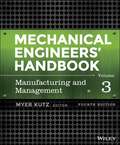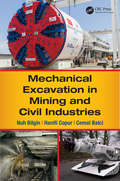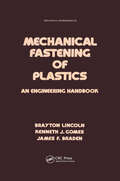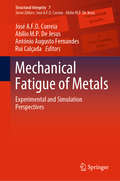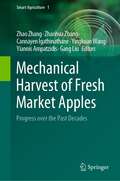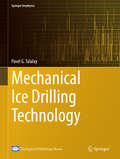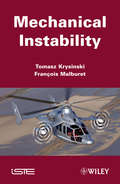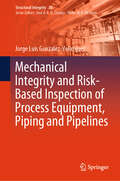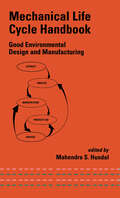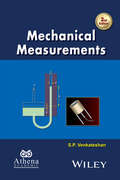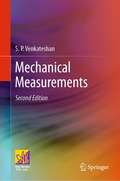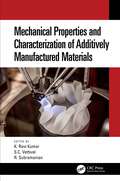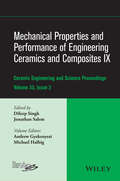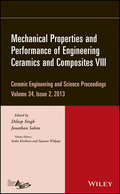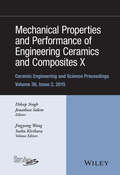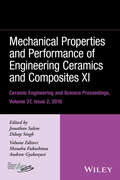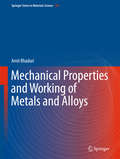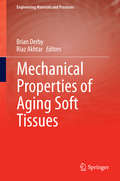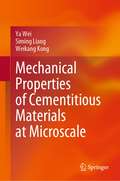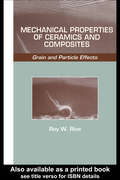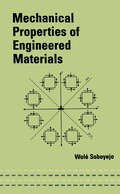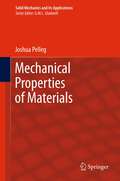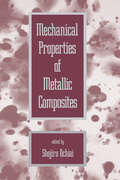- Table View
- List View
Mechanical Engineers' Handbook, Manufacturing and Management
by Myer KutzFull coverage of manufacturing and management in mechanical engineering Mechanical Engineers' Handbook, Fourth Edition provides a quick guide to specialized areas that engineers may encounter in their work, providing access to the basics of each and pointing toward trusted resources for further reading, if needed. The book's accessible information offers discussions, examples, and analyses of the topics covered, rather than the straight data, formulas, and calculations found in other handbooks. No single engineer can be a specialist in all areas that they are called upon to work in. It's a discipline that covers a broad range of topics that are used as the building blocks for specialized areas, including aerospace, chemical, materials, nuclear, electrical, and general engineering. This third volume of Mechanical Engineers' Handbook covers Manufacturing & Management, and provides accessible and in-depth access to the topics encountered regularly in the discipline: environmentally benign manufacturing, production planning, production processes and equipment, manufacturing systems evaluation, coatings and surface engineering, physical vapor deposition, mechanical fasteners, seal technology, statistical quality control, nondestructive inspection, intelligent control of material handling systems, and much more. Presents the most comprehensive coverage of the entire discipline of Mechanical Engineering Focuses on the explanation and analysis of the concepts presented as opposed to a straight listing of formulas and data found in other handbooks Offers the option of being purchased as a four-book set or as single books Comes in a subscription format through the Wiley Online Library and in electronic and other custom formats Engineers at all levels of industry, government, or private consulting practice will find Mechanical Engineers' Handbook, Volume 3 an "off-the-shelf" reference they'll turn to again and again.
Mechanical Excavation in Mining and Civil Industries
by Nuh Bilgin Hanifi Copur Cemal BalciThe secret to streamlined project scheduling is a solid understanding of basic rock cutting mechanics. Comparing theoretical values with experimental and real-world results, Mechanical Excavation in Mining and Civil Industries explains rock cutting theories for chisel, conical, disc, and button cutters. The authors provide numerical examples on the effect of independent variables on dependent variables, as well as examples from real-life mining and civil engineering jobs. The book assists students and engineers in machinery selection and performance prediction, and discusses rock cutting mechanics and mechanical miners.
Mechanical Fastening, Joining, and Assembly
by James A. SpeckGain a Deeper Understanding of Mechanical Fastening: Assemble More Efficient and Competitive ProductsA good design, quality parts, and properly executed assembly procedures and processes result in well-fastened assemblies. Utilizing a combined knowledge of mechanical assembly engineering and fastening technology, Mechanical Fastening, Joining, and Assembly, Second Edition provides readers with a solid understanding of mechanical fastening, joining, and assembly information. Based on the author’s experience in the field, this updated mechanical arts guide and reference chronicles the technical progress since the first edition was published more than a decade ago. Provides Case Studies Showing Real-World Applications for Commonly Used AssembliesThe second edition addresses recent trends in the industry, and looks at new fastening technologies used in aerospace, automotive, and other key areas. It explains the fastening function in depth, and describes the types of fastening approaches that can be used effectively. The revised text expands on the presentation and review of fastened components, detailing the assembly, design, manufacturing, and installation of fastener products and procedures. It covers specific joining applications, including vibration, standard, and special materials; details environmental factors; and provides useful reference charts for future use. What’s New in the Second Edition: Provides an up-to-date selection of technologies Contains practical approaches to modern fastener technology Reviews engineering fundamentals with a focus on their application in the fastener industry Includes a section on fastener statics Expands on fastener manufacturing processes, most specifically cold heading and roll threading Adds fastener dynamics to draw attention to forces in motion (wind turbine hub turning in strong winds) and fastener strength of materials Extends review of the economics of fastening and provides some tools for engineering economics Examines the difference in static and dynamic strengths Considers fastener materials in this new century, provides some observations about the fastener laboratory, and discusses electrical theory Addresses sustainability, application product management, thermodynamics, energy systems, and new thought maps for application analysis Takes a look at a favorite application, D&D 100, and more Mechanical Fastening, Joining, and Assembly, Second Edition is accessible to novices and experienced technologists and engineers, and covers the latest in fastener technology and assembly training.
Mechanical Fastening of Plastics: An Engineering Handbook
by Kenneth J. Gomes Brayton Lincoln James F. BradenThis text provides a unique, practical and comprehensive 'how to' introduction to plastic-to-plastic, non-permanent assemblies. Covering a full range of information in an easy to understand, nontechnical format, this outstanding work affords the confident understanding needed to keep pace with advances in plastic technology.
Mechanical Fatigue of Metals: Experimental and Simulation Perspectives (Structural Integrity #7)
by José A.F.O. Correia Abílio M.P. De Jesus António Augusto Fernandes Rui CalçadaThis volume contains the proceedings of the XIX International Colloquium on Mechanical Fatigue of Metals, held at the Faculty of Engineering of the University of Porto, Portugal, 5-7 September 2018. This International Colloquium facilitated and encouraged the exchange of knowledge and experiences among the different communities involved in both basic and applied research in the field of the fatigue of metals, looking at the problem of fatigue exploring analytical and numerical simulative approaches. Fatigue damage represents one of the most important types of damage to which structural materials are subjected in normal industrial services that can finally result in a sudden and unexpected abrupt fracture. Since metal alloys are still today the most used materials in designing the majority of components and structures able to carry the highest service loads, the study of the different aspects of metals fatigue attracts permanent attention of scientists, engineers and designers.
Mechanical Harvest of Fresh Market Apples: Progress over the Past Decades (Smart Agriculture #1)
by Zhao Zhang Zhaohua Zhang Cannayen Igathinathane Yingkuan Wang Yiannis Ampatzidis Gang LiuThis book presents the progress, changes, and evolvement for apple mechanical harvest during the past decades, which include, but not limited to, bulky harvest method, harvest platform, apple infield sorting, and harvest robotics. Though there are significant progresses in apple harvest robotics, there still is a long way ahead before its practical applications, with existing and potential bottlenecks described in this book. Hence, other researchers would take advantage of this book to have a hint of the apple mechanical harvest history and state-of-the-art progress, so that they can find the room for their new research. This book targets senior undergraduates and more importantly graduate students in the field of agricultural engineering, sensing, automatic, and robotics.
Mechanical Ice Drilling Technology
by Pavel G. TalalayThis book provides a review of mechanical ice drillingtechnology, including the design, parameters, and performance of various toolsand drills for making holes in snow, firn and ice. The material presents the historicaldevelopment of ice drilling tools and devices from the first experience takenplace more than 170 years ago to the present day and focuses on the modernvision of ice drilling technology. It is illustrated with numerous pictures, many of them published for the first time. This book is intended for specialistsin ice core sciences, drilling engineers, glaciologists, and can be useful forhigh-school students and other readers who are very interested in engineeringand cold regions technology.
Mechanical Instability (Wiley-iste Ser.)
by Tomasz Krysinski François MalburetThis book presents a study of the stability of mechanical systems, i.e. their free response when they are removed from their position of equilibrium after a temporary disturbance. After reviewing the main analytical methods of the dynamical stability of systems, it highlights the fundamental difference in nature between the phenomena of forced resonance vibration of mechanical systems subjected to an imposed excitation and instabilities that characterize their free response. It specifically develops instabilities arising from the rotor–structure coupling, instability of control systems, the self-sustained instabilities associated with the presence of internal damping and instabilities related to the fluid–structure coupling for fixed and rotating structures. For an original approach following the analysis of instability phenomena, the book provides examples of solutions obtained by passive or active methods.
Mechanical Integrity and Risk-Based Inspection of Process Equipment, Piping and Pipelines (Structural Integrity #30)
by Jorge Luis Gonzalez-VelazquezThis book explores Mechanical Integrity (MI) and Risk-Based Inspection (RBI) methodologies, specifically tailored for professionals in chemical, petrochemical, and petroleum refining plants. It starts with foundational aspects of equipment and pipe design and manufacturing within the process industry, followed by an introduction to prevalent damage mechanisms in metal components during service. The book then delves into the general methodology for mechanical integrity analysis, covering remaining life estimation and methods for assessing common defects found in in-service components. It further introduces the principles and overall methodology of Risk-Based Inspection, detailing approaches for evaluating Probability of Failure and Consequences, along with the application of risk matrices to formulate Inspection-Based Risk (IBR) plans. Lastly, it directs attention to the practical implementation of MI and IBR methodologies for managing the integrity of pipelines transporting liquid and gaseous hydrocarbons, aligned with API codes and ASME standards, offering a comprehensive example illustrating the development of an integrity management plan for a real-life pipeline. Through this structured approach, professionals can gain actionable strategies and insights essential for ensuring the safety and reliability of industrial plants and pipelines.
Mechanical Life Cycle Handbook: Good Environmental Design and Manufacturing (Mechanical Engineering)
by Mahendra S. HundalExplains how Design for the Environment (SFE) and Life Cycle Engineering (LCE) processes may be integrated into business an dmanufacturing practices. Examines major environmental laws and regulations in the U.S. and Europe, qualitative and quantitative analyses of ""green design"" decision variables, and heuristic search programs for a proactive future in ecological improvement.
Mechanical Measurements (Ane/Athena Books)
by S. P. VenkateshanThe first edition of this book was co-published by Ane Books India, and CRC Press in 2008. This second edition is an enlarged version of the web course developed by the author at IIT Madras, and also a modified and augmented version of the earlier book. Major additions/modifications presented are in the treatment of errors in measurement, temperature measurement, measurement of thermo-physical properties, and data manipulation. Many new worked examples have been introduced in this new and updated second edition.
Mechanical Measurements
by S.P. VenkateshanThis book focuses both on the basics and more complex topics in mechanical measurements such as measurement errors & statistical analysis of data, regression analysis, heat flux, measurement of pressure, and radiation properties of surfaces. End of chapter problems, solved illustrations, and exercise problems are presented throughout the book to augment learning. It is a useful reference for students in both undergraduate and postgraduate programs.^
Mechanical Properties and Characterization of Additively Manufactured Materials
by K. Ravi Kumar S. C. Vettivel R. SubramanianThe book highlights mechanical, thermal, electrical, and magnetic properties, and characterization of additive manufactured products in a single volume. It will serve as an ideal reference text for graduate students and academic researchers in diverse engineering fields including industrial, manufacturing, and materials science. This text Explains mechanical properties like hardness, tensile strength, impact strength, and flexural strength of additive manufactured components Discusses characterization of components fabricated by different additive manufacturing processes including fusion deposition modeling, and selective laser sintering Highlights corrosion behavior of additive manufactured polymers, metals, and composites Covers thermal, electrical, and magnetic properties of additively manufactured materials Illustrates intrinsic features and their Influence on mechanical properties of additive manufactured products This text discusses properties, wear behavior and characterization of components produced by additive manufacturing technology. These products find applications in diverse fields including design, manufacturing and tooling, aerospace, automotive industry, and biomedical industry. It will further help the readers in understanding the parameters that influence the mechanical behavior and characterization of components manufactured by additive manufacturing processes. It will serve as an ideal reference text for graduate students and academic researchers in the fields of industrial engineering, manufacturing engineering, automotive engineering, aerospace engineering, and materials science.
Mechanical Properties and Performance of Engineering Ceramics and Composites IX
by Dileep Singh Andrew L. Gyekenyesi American Ceramics Society Jonathan Salem Michael HalbigContributions from three symposia that were part of the 34th International Conference on Advanced Ceramics and Composites (ICACC), in Daytona Beach, FL, January 24-29, 2010 are presented in this volume. The broad range of topics is captured by the symposia titles, which are listed as follows: International Symposium on Ceramics for Electric Energy Generation, Storage, and Distribution (debuted in 2010); Thermal Management Materials and Technologies (debuted in 2010); and lastly, and Advanced Sensor Technology, Developments and Applications (debuted in 2010). These new symposia emerged during this ICACC meeting due to community growth and interest, and thus each of these subject areas were established as stand-alone symposia. The current volume represents 15 contributions from the above listed symposia that embody the latest developments in engineering ceramics for energy technologies, thermal management utilizing either highly conductive or insulating materials, as well as advances regarding the utilization of ceramics for sensors.
Mechanical Properties and Performance of Engineering Ceramics and Composites VIII
by Dileep Singh Soshu Kirihara Sujanto Widjaja Jonathan SalemCeramic Engineering and Science Proceedings Volume 34, Issue 2 - Mechanical Properties and Performance of Engineering Ceramics and Composites VIII A collection of 21 papers from The American Ceramic Society's 37th International Conference on Advanced Ceramics and Composites, held in Daytona Beach, Florida, January 27-February 1, 2013. This issue includes papers presented in Symposium 1 -Mechanical Behavior and Performance of Ceramics and Composites.
Mechanical Properties and Performance of Engineering Ceramics and Composites X
by Dileep Singh Jiyang Wang Jonathan Salem Soshu KiriharaThe Ceramic Engineering and Science Proceeding has been published by The American Ceramic Society since 1980. This series contains a collection of papers dealing with issues in both traditional ceramics (i.e., glass, whitewares, refractories, and porcelain enamel) and advanced ceramics. Topics covered in the area of advanced ceramic include bioceramics, nanomaterials, composites, solid oxide fuel cells, mechanical properties and structural design, advanced ceramic coatings, ceramic armor, porous ceramics, and more.
Mechanical Properties and Performance of Engineering Ceramics and Composites XI
by Andrew Gyekenyesi Dileep Singh Jonathan Salem Manabu FukushimaA collection of 23 papers from The American Ceramic Society's 40th International Conference on Advanced Ceramics and Composites, held in Daytona Beach, Florida, January 24-29, 2016. This issue includes papers presented in Symposium 1 - Mechanical Behavior and Performance of Ceramics and Composites.
Mechanical Properties and Working of Metals and Alloys (Springer Series in Materials Science #264)
by Amit BhaduriThis book is intended to serve as core text or handy reference on two key areas of metallic materials: (i) mechanical behavior and properties evaluated by mechanical testing; and (ii) different types of metal working or forming operations to produce useful shapes. The book consists of 16 chapters which are divided into two parts. The first part contains nine chapters which describe tension (including elastic stress – strain relation, relevant theory of plasticity, and strengthening methods), compression, hardness, bending, torsion – pure shear, impact loading, creep and stress rupture, fatigue, and fracture. The second part is composed of seven chapters and covers fundamentals of mechanical working, forging, rolling, extrusion, drawing of flat strip, round bar, and tube, deep drawing, and high-energy rate forming. The book comprises an exhaustive description of mechanical properties evaluated by testing of metals and metal working in sufficient depth and with reasonably wide coverage. The book is written in an easy-to-understand manner and includes many solved problems. More than 150 numerical problems and many multiple choice questions as exercise along with their answers have also been provided. The mathematical analyses are well elaborated without skipping any intermediate steps. Slab method of analysis or free-body equilibrium approach is used for the analytical treatment of mechanical working processes. For hot working processes, different frictional conditions (sliding, sticking and mixed sticking–sliding) have been considered to estimate the deformation loads. In addition to the slab method of analysis, this book also contains slip-line field theory, its application to the static system, and the steady state motion, Further, this book includes upper-bound theorem, and upper-bound solutions for indentation, compression, extrusion and strip drawing. The book can be used to teach graduate and undergraduate courses offered to students of mechanical, aerospace, production, manufacturing and metallurgical engineering disciplines. The book can also be used for metallurgists and practicing engineers in industry and development courses in the metallurgy and metallic manufacturing industries.
Mechanical Properties of Aging Soft Tissues
by Brian Derby Riaz AkhtarExploring the structure and mechanics of aging soft tissues, this edited volume presents authoritative reviews from leading experts on a range of tissues including skin, tendons, vasculature and plantar soft tissues. It provides an overview of in vivo and in vitro measurement techniques including state-of-the-art methodologies, as well as focusing on the structural changes that occur within the main components of these tissues resulting in detrimental mechanical property changes. It also highlights the current challenges of this field, and offers an insight into future developments. Age-related changes in the mechanical properties of soft tissues have a profound effect on human morbidity and mortality, and with changing global demographics, there is growing interest in this area. There has been increasing interest in robustly characterizing these mechanical changes to develop structure-property relationships, and growing awareness of the need for enhanced predictive models for computational simulations. This book seeks to address the challenges involved in applying these engineering techniques to reliably characterize these tissues. Focusing on a wide range of tissues and presenting cutting-edge techniques, this book provides an invaluable reference to academics and researchers in a range of disciplines including biomechanics, materials science, tissue engineering, life sciences and biomedicine.
Mechanical Properties of Cementitious Materials at Microscale
by Ya Wei Siming Liang Weikang KongThis book provides information on characterizing the microstructure and mechanical properties of cementitious materials at microscale. Specifically, with the intention to provide the methods of preparing the samples for the micro-scale mechanical testing, to address the techniques for measuring and analyzing the elastic modulus, the stiffness, and the fracture toughness of cementitious materials at micro scale by instrumented indentation, to describe a method for measuring and interpreting creep behavior of cementitious materials at micro scale, and to demonstrate the homogenization method for obtaining the mechanical properties of cementitious materials across scales. The information in this book is helpful to a wide readership in the field of civil engineering and materials science working with cementitious materials and other composite materials.
Mechanical Properties of Ceramics and Composites: Grain And Particle Effects
by Roy W. RiceThis book presents a comprehensive review, evaluation, and summary of the dependence of mechanical properties on grain and particle parameters of monolithic ceramics and ceramic composites. Emphasizing the critical link between fabrication and ceramic performance, the book covers the grain dependence of monolithic properties and the dependence of c
Mechanical Properties of Engineered Materials
by Wole SoboyejoFeaturing in-depth discussions on tensile and compressive properties, shear properties, strength, hardness, environmental effects, and creep crack growth, "Mechanical Properties of Engineered Materials" considers computation of principal stresses and strains, mechanical testing, plasticity in ceramics, metals, intermetallics, and polymers, materials selection for thermal shock resistance, the analysis of failure mechanisms such as fatigue, fracture, and creep, and fatigue life prediction. It is a top-shelf reference for professionals and students in materials, chemical, mechanical, corrosion, industrial, civil, and maintenance engineering; and surface chemistry.
Mechanical Properties of Human Tissues (Materials Horizons: From Nature to Nanomaterials)
by Arnab Chanda Gurpreet SinghThis monograph brings forth biomechanical research methods and outcomes on human tissue experiments such as those of the brain and the heart under a single umbrella. Different mechanical characterization techniques employed in human tissue property estimation are presented in detail. The contents also focus on a hyperelastic constitutive model (e.g., Mooney-Rivlin, Ogden) for both isotropic and anisotropic tissue characterization. It also discusses energy dissipation in soft tissues and associated viscoelasticity. Human tissues, including skin, muscles, connective tissues, and tissues in all functional organs are listed and their mechanical properties are presented in detail. These tissue properties are indispensable for computational modeling of biological systems, validation of biomechanical tissue testing, medical simulation through development of artificial phantoms and surrogates, and testing of medical devices and interventions. This book will serve as a key reference for research in tissue engineering & biomedical engineering, medical simulation, biomechanics, finite element modeling of biological systems, biomaterials, biotechnology, implant and medical device development, and healthcare wearables.
Mechanical Properties of Materials
by Joshua PellegThe subject of mechanical behavior has been in the front line of basic studies in engineering curricula for many years. This textbook was written for engineering students with the aim of presenting, in a relatively simple manner, the basic concepts of mechanical behavior in solid materials. A second aim of the book is to guide students in their laboratory experiments by helping them to understand their observations in parallel with the lectures of their various courses; therefore the first chapter of the book is devoted to mechanical testing. Another aim of the book is to provide practicing engineers with basic help to bridge the gap of time that has passed from their graduation up to their actual involvement in engineering work. The book also serves as the basis for more advanced studies and seminars when pursuing courses on a graduate level. The content of this textbook and the topics discussed correspond to courses that are usually taught in universities and colleges all over the world, but with a different and more modern approach. It is however unique by the inclusion of an extensive chapter on mechanical behavior in the micron and submicron/nanometer range. Mechanical deformation phenomena are explained and often related to the presence of dislocations in structures. Many practical illustrations are provided representing various observations encountered in actual structures of particularly technical significance. A comprehensive list of references at the end of each chapter is included to provide a broad basis for further studying the subject.
Mechanical Properties of Metallic Composites (Materials Engineering)
by Shojiro OchiaiProvides coverage of dispersion-hardened and fibre-reinforced alloys, addressing principal mechanisms, processing and applications. Mechanical behaviour based on dislocation theory and elastic-plastic mechanics is dealt with and data on advanced composites are provided.
